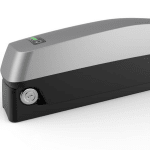 Electromobility is the answer to challenges such as the global rise in traffic, dwindling resources and climate protection. While the market for electric cars is growing only slowly, the demand for pedelecs and e-bikes is expanding at a double-digit rate. Some 1.2 million electric bicycles were sold in Europe in 2013, and in Germany, as many as one in eight new bikes is equipped with an electric motor.
Electromobility is the answer to challenges such as the global rise in traffic, dwindling resources and climate protection. While the market for electric cars is growing only slowly, the demand for pedelecs and e-bikes is expanding at a double-digit rate. Some 1.2 million electric bicycles were sold in Europe in 2013, and in Germany, as many as one in eight new bikes is equipped with an electric motor.The reasons behind this development vary, but one thing is certain: Combined with healthy locomotion using muscle power, the electric drive adds a new dynamic element and make cycling an entirely new experience. Compared to bikes powered only by electricity, this combination also increases battery range.
Stringent demands on materials
Covestro, formerly Bayer MaterialScience, recognized this trend and together with BMZ GmbH, the leading system supplier for lithium-ion batteries, developed a durable, lightweight and safe materials solution. The new UR-V5 batteries are mounted on the bike frame and can be removed for charging with an easy swivel motion. Although today's batteries for pedelecs are efficient, they are exposed to several kinds of wear and tear: On the way to the charging station and back, a battery can be dropped and hit the ground. In addition, the bikes are frequently exposed to the wind and the elements."Battery manufacturers have a number of things on their wish list when looking for suitable materials to protect the costly and sensitive inner workings of their batteries," said Dr. Constantin Schwecke, Covestro expert for polycarbonate material solutions in the electromobility segment. "The materials must be highly impact resistant, even with the thin walls required today for compact and lightweight batteries."
Bayblend FR3040, a blend of polycarbonate and acrylonitrile butadiene styrene (PC+ABS) from Covestro, proved to be the material of choice for the cell holder inside the battery and also for the insulating plates.
This flame-retardant grade fulfills the high standards of Underwriters Laboratories: The product achieves UL 94V V-0 classification at a wall thickness of 0.75 millimeters, and V-1 at 0.6 millimeters. "With this combination of properties, and particularly with its outstanding flame-retardance, this plastic is ideally suited for batteries," said Erik Baer, senior project manager for e-bikes at BMZ.

Efficient processing
For the housing components, BMZ uses impact-resistant Bayblend T65 XF, which was developed specifically for such applications. Thanks to its good ductility and flow characteristics, it can be processed efficiently even in the thin wall thicknesses that are in demand today. As an amorphous material, Bayblend T65 XF lends itself to precision injection molding, a clear advantage when you want to prevent water from penetrating the housing. Based on rheological simulations, Covestro has further optimized injection molding processes for this application.Drawing on its competence and experience, the company also has developed material solutions for other applications in the road traffic segment. For instance, shatter-resistant helmets made of Makrofol and protective cycling glasses and motorcycle helmet visors made of Makrolon provide for increased rider safety.
Beyond their use in pedelecs, rechargeable batteries from BMZ play an important role in many other mobile power supply applications. These power houses are found in wind turbines, yard tools and household devices, in communications and electronics components, in medical equipment and now also in battery storage devices for photovoltaic systems.


